Made in the Shade: Ten Native Plants for Shady Gardens
-
Barbara Robertson
-
Given a looming drought and my growing awareness of the importance of earth-friendly gardening, I decided to try making my shady backyard less thirsty and more environmentally nurturing by finding shade-tolerate natives.
Fortunately, I’m in the UC Marin Master Gardeners’ Native Plant Guild, and the guild’s study list of 60 plants gave me a jump-start. A quick search for “shade” produced several “full sun, part shade” plants.
When giving light requirements, horticulturists list the preferred amount of light first and the level a plant can probably tolerate second. Full sun is easy to grasp, but there are degrees of shade. Light shade describes an area receiving three to five hours of direct sun in summer. Partial shade means two hours of direct sun, or shade for at least half the day. Full shade describes areas with less than an hour of direct sun each day or that have dappled light most of the day.
There are subtleties given the words “full sun,” such as the difference between cool morning sun and hot afternoon sun, and coast versus inland. But, I wanted the surest bets. So, I narrowed the search to “shade” specified first and created a starter list of ten native shade plants. Happily, all but the fern support wildlife with flowers and some with berries. The list includes ground covers, vines, shrubs, trees, and flowers for every season.
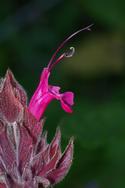 Photo: Alan Schmierer
Photo: Alan SchmiererSalvia spathacea (Hummingbird Sage) – full shade, part shade.
The sprawling drought-tolerant, evergreen ground cover produces 3-foot stems with fuchsia flowers in the spring and summer. Hummingbirds love it. Excellent under oaks, the fragrant, fruity foliage of the deer-resistant Salvia spathacea (Hummingbird Sage) plant spreads by rhizomes.
Satureja douglasii (Yerba Buena) – full shade, part shade.
This sweet creeping yet non-invasive evergreen perennial has white flowers in spring and summer. The delicate-looking ground cover likes a moist woodland setting. Leaves and flowers are edible and fragrant.
Fragaria chiloensis (Coastal Strawberry) – part shade, full sun.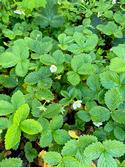 Photo: Barbara Robertson
Photo: Barbara RobertsonThis evergreen ground cover has white flowers in winter and spring followed by tiny edible fruit. It prefers well-draining sandy soil, watering a maximum of three times per month, and can be a lawn replacement. Tiny red berries follow the winter and springtime white flowers of the Fragaria chiloensis (Coastal Strawberry) plants.
Symphyotrichum chilense (Coast Aster) – part shade, full sun.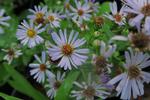 Photo: John Rusk
Photo: John RuskThe perennial native’s blue daisy-like flowers bloom prolifically to support pollinators and beneficial insects in late summer and fall. It will disappear or need to be pruned to the ground in winter, only to reappear in the spring. It can grow fast to three-feet tall by three-feet wide with irrigation, and can re-seed. Symphyotrichum chilense (Coast Aster) is a nectar source for butterflies, performs well in any soil, and attracts many beneficial insects.
Lonicera hispidula (California Honeysuckle) – part shade.
A winter-deciduous plant, this versatile, drought tolerant, soil tolerant, fast growing, and possibly deer-proof native can be a vine, shrub, or groundcover. Birds like the berries. Hummingbirds adore the pink flowers in spring and summer.
Ribes viburnifolium (Catalina Currant) – part shade.
The drought-tolerant, low-growing evergreen shrub can become three feet tall by 10 feet wide or kept smaller. Long red stems sport clusters of deep red flowers in late winter and early spring followed by red berries loved by birds.
Diplacus (Mimulus) aurantiacus (Sticky Monkey Flower) – part shade, full sun.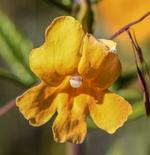 Photo: Jerry Kirkhart
Photo: Jerry KirkhartKnown for sticky leaves that host butterfly larvae, and tubular orange flowers winter, spring, and summer that attract bees and hummingbirds, the deer-resistant and drought-resistant evergreen shrub can grow to four-feet by five-feet. Plant Diplacus (Mimulus) aurantiacus (Sticky Monkey Flower) to attract bees and hummingbirds and host butterfly larvae.
Acer circinatum (Vine Maple) – shade, part shade.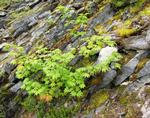 Photo: Brew Books
Photo: Brew BooksA striking addition to the garden, the large deciduous shrub/small tree has reddish spring foliage, orange leaves in fall, and red flowers in spring for birds and butterflies. It wants well-draining soil and no water once established. The versatile Vine Maple's light green leaves turn orange-scarlet in fall. Springtime red flowers attract birds and butterflies.
Myrica californica (Pacific Wax Myrtle) – part shade, full sun.
Sometimes sheered as a hedge, sometimes grown as a tree, this evergreen native has dark green leaves and yellow flowers in early summer. It can grow fast to 30 feet tall by 20 feet wide. It’s drought-tolerant and thrives in a variety of soil compositions.
Polystichum munitum (Western Sword Fern) – full shade, part shade.
This fern’s tall shiny upright fronds can create the illusion of lushness in a garden. It’s summer semi-deciduous / evergreen and somewhat drought-tolerant when established, but better with weekly deep watering.
For extensive lists and gorgeous photos of plants appropriate for all types of Marin gardens visit http://marinmg.ucanr.edu/PLANTS/





